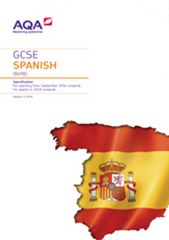3.3 Grammar
The grammar requirements for GCSE are set out in two tiers: Foundation Tier and Higher Tier.
GCSE students will be expected to have acquired knowledge and understanding of Spanish grammar during their course. In the exam they will be required to apply their knowledge and understanding, appropriate to the relevant tier of entry, drawing from the following lists. The examples in brackets are indicative, not exclusive. For structures marked (R), only receptive knowledge is required.
Students will be expected to develop and use their knowledge and understanding of this grammar progressively throughout their course.
Foundation Tier
Nouns
gender
singular and plural forms
Articles
definite and indefinite
lo plus adjective (R)
Adjectives
agreement
position
comparative and superlative: regular and mayor, menor, mejor, peor
demonstrative (este, ese, aquel)
indefinite (cada, otro, todo, mismo, alguno)
possessive, short form (mi)
possessive, long form (mío) (R)
interrogative (cuánto, qué)
Adverbs
formation
comparative and superlative: regular
interrogative (cómo, cuándo, dónde)
adverbs of time and place (aquí, allí, ahora, ya)
common adverbial phrases
Quantifiers/intensifiers
(muy, bastante, demasiado, poco, mucho)
Pronouns
subject
object (R)
position and order of object pronouns (R)
reflexive
relative: que
relative: quien, lo que (R)
disjunctive (conmigo, para mí)
demonstrative (éste, ése, aquél, esto, eso, aquello)
indefinite (algo, alguien)
interrogative (cuál, qué, quién)
Verbs
regular and irregular verbs, including reflexive verbs
all persons of the verb, singular and plural
modes of address: tú and usted
radical-changing verbs
negative forms
interrogative forms
reflexive constructions (se puede, se necesita, se habla)
uses of ser and estar
Tenses:
- present indicative
- present continuous
- preterite
- imperfect: in weather expressions with estar, hacer
- imperfect (R)
- immediate future
- future (R)
- perfect: most common verbs only
- conditional: gustar only in set phrases
- pluperfect (R)
- gerund (R)
- imperative: common forms including negative
- subjunctive, present (R) in certain exclamatory phrases (¡Viva! ¡Dígame!)
- subjunctive, imperfect: quisiera
- impersonal verbs: most common only.
Prepositions
common, including personal a
por and para
Conjunctions
common, including y, pero, o, porque, como, cuando
Number, quantity, dates
Time
Use of desde hace with present tense (R)
Higher Tier
Students entering for Higher Tier assessments will be required to apply all grammar and structures listed for Foundation Tier, in addition to the new grammar and structures listed for Higher Tier.
Articles
lo plus adjective
Adjectives
comparative and superlative
possessive, short and long forms (mi, mío)
relative (cuyo)
Adverbs
comparative and superlative
Pronouns
object
position and order of object pronouns
relative: all other uses including quien, lo que, el que, cual
possessive (el mío, la mía)
Verbs
Tenses:
- future
- imperfect
- imperfect continuous
- perfect
- pluperfect
- conditional
- passive voice (R)
- gerund
- present subjunctive: imperative, affirmation and negation, future after conjunctions of time (cuando), after verbs of wishing, command, request, emotion, to express purpose (para que)
- imperfect subjunctive (R).
Time
- use of desde hace with present tense
- use of desde hace with imperfect tense (R).
